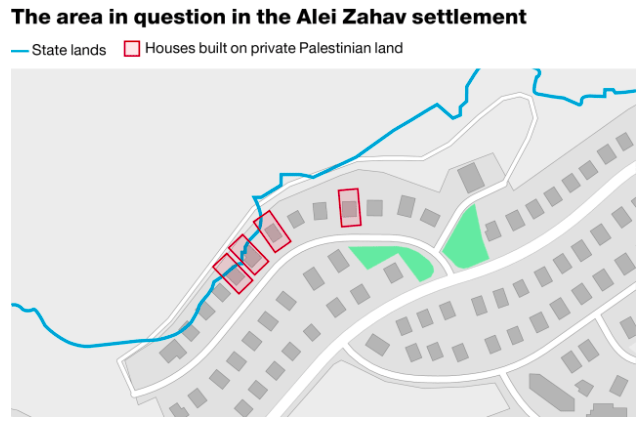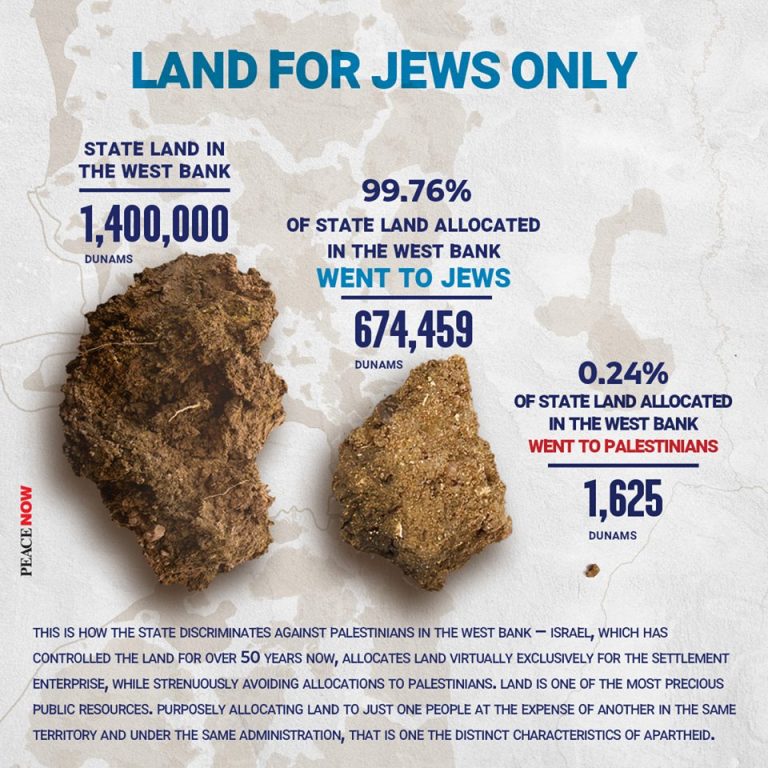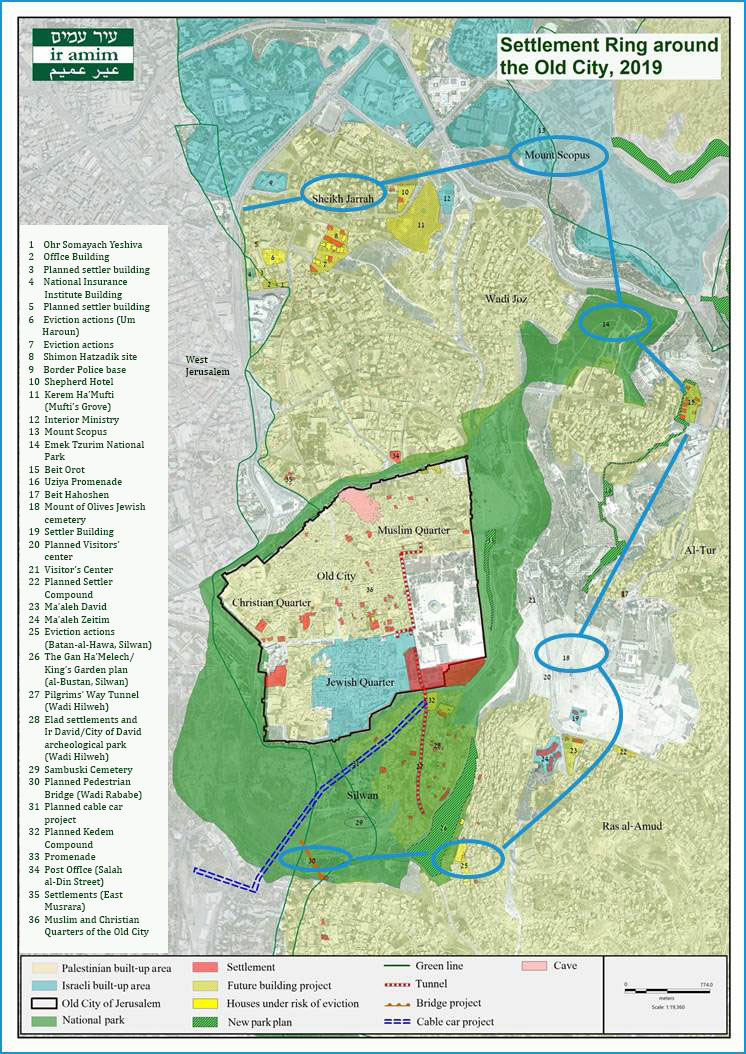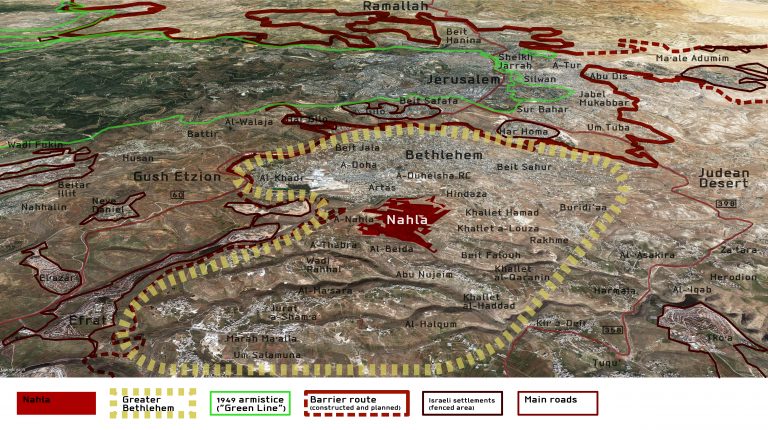Welcome to FMEP’s Weekly Settlement Report, covering everything you need to know about Israeli settlement activity this week.
To subscribe to this report, please click here.
February 15, 2019
- Israel Announces Plan to Retroactively Legalize Settlement Units Built on Privately Owned Palestinian Land
- Jerusalem Planning Authorities Are Quietly Advancing Sensitive Settlement Projects in East Jerusalem
- Peace Now Files Appeal Against Settler Land Grab for New “E-2/Givat Eitam” Settlement
- Peace Now Petitions High Court to End Flow of Public Funds to Settler Organization
- AG Paves Way for Ariel Medical School to Open, Despite Rejection by Key Committee
- Following Expulsion of International Observers, Emboldened Settlers Attack Palestinians
- Yitzhar Settlers Attack Palestinian School, So IDF Restricts Palestinian Access to Roads to Allow Yitzhar Settler Protests
- NEW: Ir Amim Publishes 2019 Map of Settlement Projects In and Around Jerusalem’s Old City
- Bonus Reads
Questions/comments? Email kmccarthy@fmep.org
Israel Announces Plan to Retroactively Legalize Settlement Units Built on Privately Owned Palestinian Land
On February 10th, the Israeli government informed the Jerusalem District Court that it plans to invoke the “market regulation” principle in order to retroactively legalize four structures in the Alei Zahav settlement – structures built on land that even Israel acknowledges is privately owned by Palestinians.

According to Haaretz, a 2016 land survey conducted by the Israeli Civil Administration discovered the existence of privately owned Palestinian land in the settlement, which older Israeli maps had marked as “state land.” After the discovery, settlers went to court to sue the World Zionist Organization (which was allocated the land by the Israeli government), the Israeli Defense Ministry, and the contractor who built the settlement demanding that they fix the situation. The state’s response to the Jerusalem District Court this week freezes the settler’s petition while the government’s plan is implemented.
The “market regulation” principle was identified by Israeli Attorney General Avichai Mandelblit as an alternative to the settlement Regulation Law (the controversial law passed by the Knesset that, in effect, lets the Israeli government suspend the rule of law to seize privately owned Palestinian land for the benefit of settlers). Both the Regulation Law and the “market regulation” principle are designed to give Israel legal cover to retroactively legalize outposts and settlement structures that, because they are built on land that Israel acknowledges is privately owned by Palestinians, the State had been unable legalize under existing Israeli law (despite great efforts to do so). The “market regulation” principle holds that Israeli settlement construction can be retroactively legalized if it was carried out “in good faith” with government support on land that was later discovered to be privately owned by Palestinians.
The Israeli High Court is already considering a petition against the constitutionality of the “market regulation” principle, a case stemming from the State’s first attempt to implement it in order to retroactively legalize the Mitzpe Kramim outpost.
If allowed to proceed on the basis of the “market regulation” principle, the state will first have to publish an official planning scheme for the area, and allow the public (including the Palestinian landowners, as recognized by Israeli) to object. Attorney Alaa Mahajna, who is representing the Palestinian landowners involved in the case, said:
“Even without making use of the vilified expropriation law [aka the Regulation Law], the state still finds ways and uses other routes to attain the same goal, giving its legal imprimatur to robbery of land, with residents who are protected under international law.”
FMEP tracks the ongoing legislative, political, and legal transformations happening in the Israeli government to justify the expropriation of Palestinian land for the settlements in its Annexation Policy Tables.
Jerusalem Planning Authorities Are Quietly Advancing Sensitive Settlement Projects in East Jerusalem
Ir Amim reports that East Jerusalem settlement planning authorities are advancing sensitive settlement projects in East Jerusalem through secretive and expedited processes, thereby limiting the opportunity for stakeholders and the public to challenge the plans.
For example, on February 5th, the Jerusalem Local Planning and Building Committee discussed public objections filed against two settlement plans in Sheikh Jarrah. Both of the plans are being promoted by East Jerusalem settlement impresario and city council member Aryeh King. The committee did not notify those objecting to the plan that these proceedings were planned, and so no one objecting to the plan was present in the February 5th discussion. The plans, which would allow for the construction of two new buildings – one with 10 units and the other with 3 units – would involve the eviction of 5 Palestinian families from buildings that would be demolished.
On February 17th, the Jerusalem District Planning and Building Committee will consider the Glassman Yeshiva project – a plan to build a Jewish religious school, including dormitories, at the entrance to the Sheikh Jarrah neighborhood. Ir Amim reports that it is unclear what the committee will do in considering the plan, since authorities have advanced the plan outside of the normal planning process, even succeeding in have land allocated for the yeshiva despite the fact that the plan was never deposited for public review (meaning stakeholders and the public have had no opportunity to object).
Ir Amim writes:
“Despite their tremendous political and environmental sensitivity, plans are now being fast tracked, some outside of appropriate planning channels and with limited public participation, in service to decidedly political considerations and with the prominent involvement of settler associations. The new map and accompanying map notes detail the numerous projects and eviction cases now advancing.”
For an explanation of how East Jerusalem settlement planning/approval is supposed to work under Israeli law and practice, see Terrestrial Jerusalem’s presentation here.
Peace Now Files Appeal Against Settler Land Grab for New “E-2/Givat Eitam” Settlement
On February 7th, the settlement watchdog group Peace Now and dozens of Palestinian landowners filed a petition with the Israeli Custodian of Government and Abandoned Property demanding the annulment of the allocation of “state land” for the sole declared purpose of building the new “E-2/Givat Eitam” settlement. Rather than challenging Israel’s classification of the land as “state land,” the petition asks that the land be allocated instead for Palestinian use, challenging Israel’s discriminatory allocation of “state land” for the settlements. It builds on recent revelations that since 1967, Israel has allocated a jaw-dropping 99.8% of state land in the West Bank to settlements and just 0.2% for Palestinians.
Rather than challenging Israel’s classification of the land as “state land,” the petition asks that the land be allocated instead for Palestinian use, challenging Israel’s discriminatory allocation of “state land” for the settlements. It builds on recent revelations that since 1967, Israel has allocated a jaw-dropping 99.8% of state land in the West Bank to settlements and just 0.2% for Palestinians.
The petition argues that the allocation of state land for the exclusive use of settlements/settlers is illegal both under the Hague Conventions and under domestic anti-discrimination laws in Israel.
Regarding the new petition, Peace Now says:
“Since the 1979 Elon Moreh ruling, no petition has succeeded in undermining the legal infrastructure that enables the ongoing expansion of the settlement enterprise. This initiative and the surrounding public struggle aims to undermine the prevailing view that “state land” in the occupied territories effectively constitutes land available for Israeli use, and to obligate the Supreme Court and the Israeli public, to address this fundamental question.”
Israel announced on December 26, 2018 that it will draft plans to build as many as 2,500 new settlement units at the Givat Eitam outpost site, creating a new settlement on a strategic hilltop that will cut off Bethlehem from the southern West Bank, completing the encirclement of Bethlehem by Israeli settlements.
The Givat Eitam outpost has been nicknamed “E-2” by settlement watchers for for its resemblance, in terms of dire geopolitical implications, to the infamous E-1 settlement plan. Located east of the separation barrier on a strategic hilltop overlooking the Palestinian city of Bethlehem to its north, the site of Givat Eitam/E-2 is within the municipal borders of the Efrat settlement but is not contiguous with Efrat’s built-up area. As such, Givat Eitam/E-2 would effectively be a new settlement that, according to Peace Now, would:
“block Bethlehem from the south, and prevent any development in the only direction that has not yet been blocked by settlements (the city is already blocked from the North by the East Jerusalem settlements of Gilo and Har Homa, and from the West by the Gush Etzion Settlements) or bypass roads (that were paved principally for Israeli settlers). The planned building in area E2 would likely finalize the cutting off of Bethlehem city from the southern West Bank, delivering a crushing blow to the Two States solution.”
Peace Now Petitions High Court to End Flow of Public Funds to Settler Organization
The settlement watchdog group Peace Now has filed a petition with the High Court of Justice to stop public funding flowing to the radical Amana settler organization, which is a private, for-profit entity engaging in various illegal activities to establish and expand Israeli settlements and outposts across the West Bank.
The new petition is based on Peace Now’s investigative work revealing the substantial amount of money that has been secretly funneled to Amana through settlement regional councils. The settlement regional council budgets obtained by Peace Now revealed that money allocated to support non-profit public welfare groups was instead being used to fund Amana. Funding for Amana in this manner violates Israeli Interior Ministry policies prohibiting public subsidies for private, for-profit entities – and it is this funding that Peace Now is petitioning the High Court to end.
Peace Now’s work is backed up two separate reports of the Israeli Comptroller’s office, one from November 2017 and another from July 2018, which detailed the extent to which the Binyamin Regional Council – the largest settlement regional council – secretly funneled money to organizations engaged in illegal settlement construction. The July 2018 report revealed that the Binyamin Regional Council funneled $10 million to Amana between 2013-2015 alone.
Peace Now said in a statement:
“This grave phenomenon in which taxpayers’ money is transferred to an organization that has specialized in construction violations for decades, is against the law and regulations; an organization that works tirelessly to change reality by illegally establishing unauthorized facts on the ground, is dire and must be stopped. Only a complete cessation of this cash flow will prevent further construction rampages throughout the West Bank, and retain the opportunity for a future agreement.”
AG Paves Way for Ariel Medical School to Open, Despite Rejection by Key Committee
On February 13th, Israeli Attorney General Avichai Mandelblit announced that the vote last week by the Planning & Budgeting Committee of the Council for Higher Education in Israel is a non-binding recommendation, and that the fate of the Ariel settlement’s new medical school will be determined by a final vote to be held by the council’s main body. In so doing, Mandelblit made it possible for the main body of the Council for Higher Education in Israel to vote against its own professional subcommittee, contrary to the normal practice. Indeed, Haaretz columnist Or Kashti even called it “unreasonable.”
Mandelblit said that the Council for Higher Education in Israel should reconvene to vote within the next two months in order to give the medical school, its faculty, and its students, adequate time to prepare. Haaretz reports that Education Minister Naftali Bennett – who serves as the Chairman of the Council for Higher Education in Israel – is expected to delay the vote until he is confident that he has enough votes in favor of approving the medical school.
In addition, Mandelblit also allowed the West Bank arm of the Council for Higher Education – a settler body which oversees and promotes educational institutes located in West Bank settlements (i.e. outside of sovereign Israeli territory) – to take vote on the matter. Unsurprisingly, on Feb. 13th the settler body voted unanimously to approve the medical school. It did so in a vote that was held in the final hours before that settler body was absorbed by Council for Higher Education in Israel, following a law passed by the Israeli Knesset in Feb 2018 that extends the jurisdiction of the Council for Higher Education in Israel to include schools in the settlements (an act of de facto annexation).
Weighing in on the debate, the Haaretz Editorial Board noted that supporters of the Ariel medical school – including Naftali Bennett – lobbied for the settlers’ own Council for Higher Education to be permitted to vote on the matter in an attempt to overrule the Planning & Budgeting Committee’s unfavorable decision. The Board writes:
“In a country governed by the rule of law, the [Planning & Budgeting] committee’s latest vote should have settled the matter. But Ariel University and its supporters, above all Education Minister Naftali Bennett, have ways to circumvent the committee. We will soon find out whether Mendelblit will approve this move, enabling Ariel to overcome the professional objections of the Planning and Budgeting Committee, the opposition of the other universities and Wadmany Shauman’s conflict of interest. This hasty resort to the Council for Higher Education in Judea and Samaria – which has never dealt with budgetary issues, only ideological ones – should set off alarm bells. After the Planning and Budgeting Committee’s previous vote, approving the med school, no one demanded reaffirmation from the council. That’s not how the higher education system should operate. The Planning and Budgeting Committee steers its course, including the disbursal of its 11 billion shekel ($3 billion) annual budget.”
As FMEP has previously reported, Ariel University became an accredited Israeli university in 2012, following significant controversy and opposition, including from Israeli academics. It has since been the focus of additional controversy, linked to what is a clear Israeli government-backed agenda of exploiting academia to normalize and annex settlements. In 2018, the settlement broke ground on the new medical school, with significant financial backing from U.S. casino magnate, settlement financier, and Trump backer Sheldon Adelson. In February 2018, in an act of deliberate de facto annexation, the Israeli Knesset passed a law extending the jurisdiction of the Israeli Council on Higher Education over universities in the settlements (beyond Israel’s recognized sovereign borders), ensuring that the Ariel settlement medical school (and its graduates) would be entitled to all the same rights, privileges, and certifications as schools and students in sovereign Israel.
The Ariel settlement is located in the heart of the northern West Bank, reaching literally to the midpoint between the Green Line and the Jordan border. The future of Ariel has long been one of the greatest challenges to any possible peace agreement, since any plan to attach Ariel to Israel will cut the northern West Bank into pieces.
Following Expulsion of International Observers, Emboldened Settlers Attacks on Palestinians
In the week since Israeli Prime Minister announced that he would not renew the mandate of the Temporary International Presence in Hebron (TIPH) – in effect, expelling international observers from the city – radical, violent settlers have repeatedly harassed and attacked Palestinians, including school children. Thus far the Israeli military has failed to intervene to stop the encounters.
Following the expulsion of the observers, who previously escorted Palestinian school children on their daily commute near settlement enclaves in downtown Hebron, Palestinians formed a volunteer group to escort and protect the children. On February 10th, alarming video footage shows settlers harassing and attacking this new group as it was escorting children. In response, the Israeli army issued an order on Feb. 13th that declared the area as a closed military zone, barring the volunteers from escorting the students.
On the evening of February 12th, a group of settlers attacked Palestinian homes on Shuhada Street, the main street in downtown Hebron which Israel has “sterilized” by preventing all Palestinian vehicles, limiting Palestinian pedestrians, and relegating Palestinian foot traffic to a specific area. One Palestinian resident reported that a settler jumped onto his roof and broke into his home; the IDF had to escort the settler out, and disperse the group of settlers who were chanting anti-Palestinian threats. Video footage captured the scenes.
Yitzhar Settlers Attack Palestinian School, So IDF Restricts Palestinian Access to Roads to Allow Yitzhar Settler Protests
On February 10th, dozens of settlers from the Yitzhar settlement descended from their hilltop neighborhood to violently attack a high school in the Palestinian village of Urif. According to reports, high school students clashed with IDF soldiers who were providing protection for the raiding group of settlers. Ten students reportedly required medical care for tear gas inhalation.
The next day, on February 11th, the Israeli IDF sealed off several roads near the Yitzhar settlement to allow the settlers to assemble to protest against “the deteriorating security situation in the West Bank.”
The anti-settlement group Yesh Din recently published a report, entitled “Yitzhar – A Case Study,” chronicling the violence of the Yitzhar settlement, and how that violence is used as a strategic means to take over Palestinian land.
NEW: Ir Amim Publishes 2019 Map of Settlement Projects In and Around Jerusalem’s Old City
 Ir Amim released an updated map showing settler activities around Jerusalem’s Old City.
Ir Amim released an updated map showing settler activities around Jerusalem’s Old City.
Announcing the new map, Ir Amim writes:
“Ir Amim’s latest map, ‘Settlement Ring around the Old City, 2019,’ graphically illustrates the accelerated, intensifying chain of new facts on the ground in the most historically contested and politically sensitive part of Jerusalem: the Old City and adjacent ring of Palestinian neighborhoods. In addition to a mounting number of state-sponsored settlement campaigns inside Palestinian neighborhoods – settler initiated evictions of Palestinians, takeovers of their homes, and the expansion of settler compounds – touristic settlement sites function as key points along a ring of tightening Israeli control….These projects – including promenades, national parks and visitor centers – serve manifold purposes: They connect otherwise isolated and relatively small settlement compounds inside Palestinian neighborhoods, creating a contiguous ring of settler controlled areas; They fracture the Palestinian space, disrupting freedom of movement and breaking large neighborhoods into smaller, easier to police enclaves;While the number of ideologically driven settlers living inside Palestinian neighborhoods may still be relatively small, tens of thousands of non-ideological Israeli tourists visiting these sites serves to strengthen the Jewish presence inside Palestinian areas of the city.”
The map can be downloaded here and accompanying detailed notes here.
Bonus Reads
- “Why Residents of Jerusalem’s Sheikh Jarrah Face Eviction” (Al-Monitor)
- “Imminent Eviction of Palestinian family in East Jerusalem” (OCHA)
- “Two Jewish Groups’ Disagreement Over Jewish Law Might Dash Jerusalem’s Dreams (Haaretz)
- “What Kind of Occupation do Israelis Want?” (Ynet)
